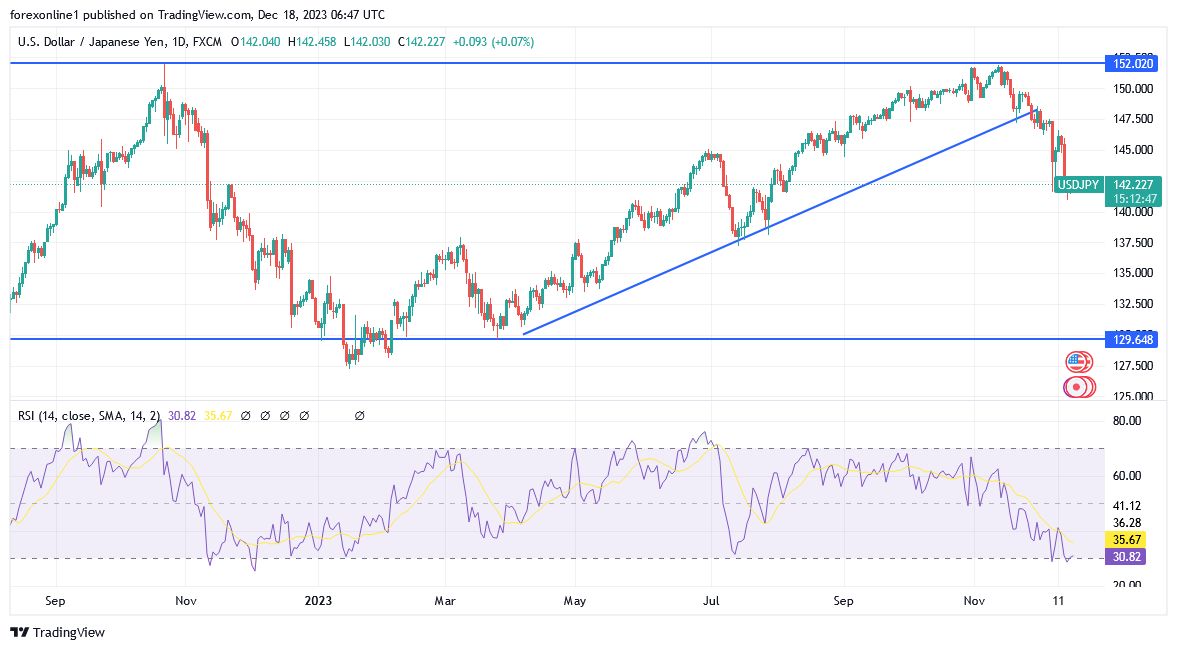The US dollar rebounded ahead of the weekend last week after one of the Federal Open Market Committee members said that his colleagues should be prepared to raise interest rates again if necessary. As a result, the downtrend of the USD/JPY pair, which pushed it towards the 140.95 support level, the pair's lowest level in more than 4-months. Recently, the pair closed the trading around 142.09 after testing the 142.46 resistance in the same trading session.
Top Forex Brokers
According to John Williams, the president of the Federal Reserve Bank of New York, the Federal Reserve will remain data dependent. Therefore, if the trend of easing inflation reverses, it will be prepared to tighten policy again. As a result, the markets interpreted the comments as a retreat from the rapid rise in market bets for a Fed rate cut in 2024.
Meanwhile, the market boosted expectations for early cuts after the Federal Reserve's mid-week update and policy guidance, in which Fed Chair Jerome Powell said that the central bank should be wary of keeping interest rates at restrictive levels for too long. Also, the markets interpreted this and other parts of the guidance as a disregard for market expectations for a US rate cut. The US dollar had fallen sharply in response, making it vulnerable to a rebound due to any contrary comment. This comment came from Williams, who told CNBC: "We are not really talking about interest rate discounts." He added, "I think it's too early to think about it," Williams added when asked about the money market pricing to reduce interest rates in March.
Other factors that will affect the performance of the USD/JPY, the Bank of Japan when it sets its policy tomorrow, Tuesday, as Governor Haruhiko Kuroda continues his steps towards ending the world's last negative interest rate system. However, that is unlikely to happen this time. People familiar with the matter say that the Japanese authorities are in no hurry to move as they await concrete evidence of sustainable inflation.
Therefore, Bank of Japan watchers will be looking for clues in Kuroda's statement and comments about the outlook for wage growth and the chances of improved wages stimulating spending and demand-driven inflation. Any upward nudge would support growing expectations that the Bank of Japan will raise rates as soon as April, as three-quarters of economists polled by Bloomberg earlier this month predicted. On the surface, the Bank of Japan's task may seem a bit awkward after the US Federal Reserve announced rate cuts in 2024. Meanwhile, it is important to remember that the Bank of Japan has no intention of introducing restrictive settings. Therefore, If Kuroda ends the negative rate, the governor will emphasize that policy remains broadly accommodative.
On the other hand, the United States will get the latest major inflation for this year with the report of personal consumption expenses, which is the preferred measure of the Federal Reserve. Obviously, it is expected that the price of personal consumption expenses for the second month will stabilize in November, while the basic index that excludes the prices of food and energy will increase by 0.2 %. Currently, both scales are expected to decline on an annual basis, which supports more soft-landing forecasts in The Federal Reserve turned towards reducing American interest rates.
USD/JPY Technical analysis and Expectations Today:
The USD/JPY decreased to the lowest new level in 21 weeks at about 140.95 before he bounced again, but with caution. Technically, it appears that the currency pair is about to complete the side penetration of the formation of the declining canal sharply. Recently, USD/JPY had decreased to circulate at several levels of the moving average line for 100 hours. Purely, the late recovery at the end of last week helped the currency pair to recover from the levels of saturation in the sale of the relative power index for 14 hours.
In the short term, based on the performance on the hourly chart, it appears that the USD/JPY is on the verge of completing a sharp breakout from the descending channel formation. Nearby, the 14-hour Relative Strength Index (RSI) seems to support a potential rebound after recovering from oversold conditions. Therefore, bullish traders will target extended rebounds around 142.35 or higher at the resistance of 142.84. On the other hand, bearish traders will look for profit-taking around 141.40 or lower at the support of 140.97.
In the long term, based on the performance on the daily chart, the USD/JPY currency pair seems to be trading within a descending channel. Also, the 14-day Relative Strength Index indicates a long-term bearish bias as it approaches oversold conditions. Therefore, bearish traders will look to ride the current downward wave towards 138.80 or lower towards the support of 135.99. On the other hand, bullish traders will target long-term profits around 144.85 or higher at the resistance of 147.66.

Ready to trade our Forex daily forecast? We’ve shortlisted the best forex broker list for you to check out.

